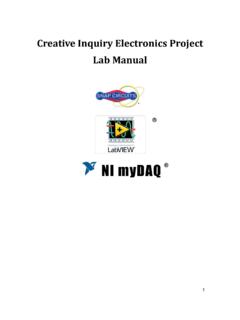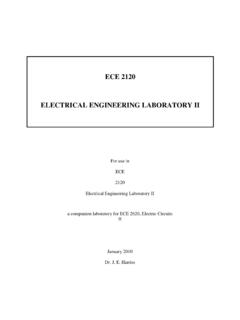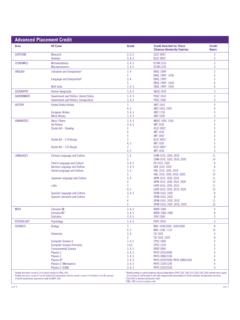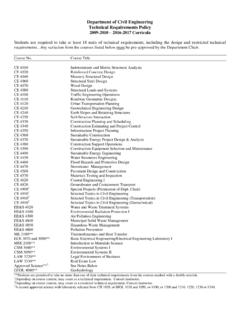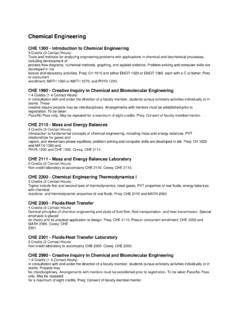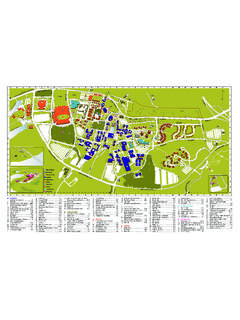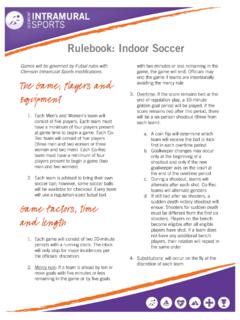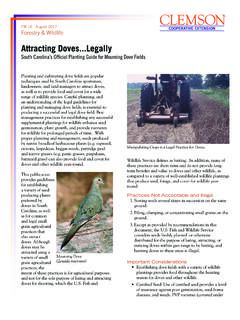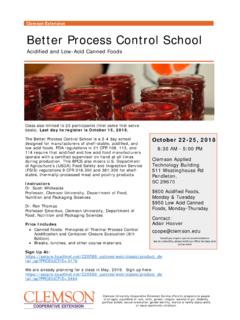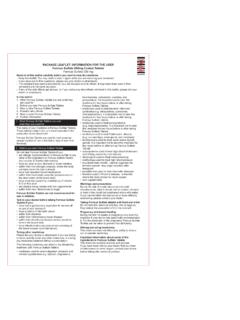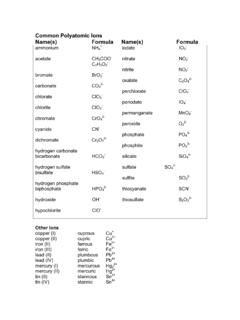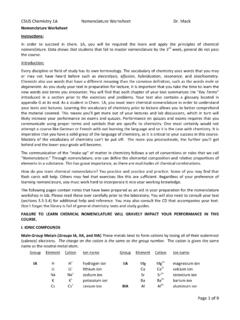Transcription of 3. Micronutrients - Clemson University
1 3. Micronutrients There are 7 essential plant nutrient elements defined as Micronutrients [boron (B), zinc (Zn), manganese (Mn), iron (Fe), copper (Cu), molybdenum (Mo), chlorine (Cl)]. They constitute in total less than 1% of the dry weight of most plants. The following discussion focuses primarily on the soil characteristics for the Micronutrients . a. Boron (B) Boron is included in the Standard Soil Test. The level of soil boron is insufficient or low when extractable boron is less than pound per acre. Soil boron is found in both organic and inorganic forms that are made available to plants as either or both soil organic matter is decomposed and/or boron-containing minerals dissolve.
2 There may be between 20 to 200 pounds boron in the surface layer of South Carolina soils, but only a small portion is available to plants. Boron, as the borate (BO33-) anion, is mobile in the soil and can be easily leached from the surface soil. Calcium, potassium, and nitrogen concentrations in both the soil and plant can affect boron availability and plant function, the calcium:boron (Ca:B) ratio relationship being the most important. Therefore, soils high in calcium will require more boron than soils low in calcium. The chance for boron toxicity is greater on low calcium-content soils.
3 The need to include boron in the fertilizer recommendation is determined by: crop requirement soil boron test level For any given crop when boron is recommended, a high rate of boron may be required on: clay-type soils soils that are high in water pH and/or calcium content high organic matter content soils soils where boron is broadcast versus boron being either banded or foliar applied Boron is routinely included in the fertilizer recommendation for the crops cotton, peanut, alfalfa, apple, root crops, cabbage, broccoli, and cauliflower, and when reseeding clover or where clover seeds are to be harvested.
4 When applied as a part of a soil fertility program, many types of animal manures, superphosphate (0-20-0), and liming materials may contain sufficient boron to meet the boron requirement for some crops. Crops differ in their sensitivity or tolerance to boron, crops most sensitive being peach, strawberry and soybean; corn, tobacco, tomato and small grains being moderately tolerant to boron; while the crops, cotton, sunflower and alfalfa are the most tolerant. When boron deficiency symptoms occur, boron is recommended at application rates determined by crop as given below.
5 Application Rates of Boron Recommended for Correcting Boron Deficiency by Crop Crop Amount Applied Crop Amount Applied Alfalfa Grapes Apple Peanut Cabbage Pea Carrot Potato Clovers Strawberry Corn Sweet Potato Cotton Tomato Care is needed not to exceed both recommended boron soil and foliar application rates since boron toxicity is a definite possibility. A plant analysis is the best method for determining when boron is actually needed. Soil test boron is excessive when extractable boron is greater than pounds per acre.
6 Boron exists in the soil solution as the borate (BO33-) anion. List of Boron-containing Commercial Fertilizers: Source Formula % B Content Borax 11 Boric Acid H3BO3 16 Solubor + 20 b. Zinc (Zn) Zinc is included in the Standard Soil Test. The level of soil zinc is insufficient or low when extractable zinc is less than pounds per acre and the soil pH is less than , and when extractable zinc is less than pounds per acre and the soil pH greater than Zinc deficiency has been observed on early-planted corn during cool, wet periods, but plants usually recover as the soil dries and warms.
7 Zinc is routinely recommended for corn grown on sandy soils (Soil Groups 1 and 2) when the soil pH is above A zinc application is normally recommended for pecan unless a plant analysis indicates that zinc is not required. A zinc recommendation for peach and apple is not generally made unless a deficiency is verified by means of a leaf analysis. Both soil and plant analyses are to be used to determine if a zinc deficiency exists. When soil zinc is insufficient , zinc is recommended for certain crops, the treatment rate being between 3 to 5 pounds zinc per acre.
8 To correct a zinc deficiency in peach, plum or nectarine trees, foliar apply either chelated zinc, following label directions, or apply at three-week intervals a solution containing 3 ounces zinc sulfate ( ) dissolved in 100 gallons of water. If a zinc-containing fungicide is being applied to the foliage, additional zinc as either soil or foliar applied will not be required. In old peach orchards, zinc soil toxicity can occur following years of applying zinc-containing fungicides. Repeated use of sludge, slag, or poultry litter, all of which can contain high concentrations of zinc, may result in soil zinc toxicity.
9 The potential for a zinc toxicity can be reduced or eliminated by liming the soil to raise the water pH above or , the pH level normally recommended for the crop growing or to be grown. Peanut is particularly sensitive to zinc and this element can be toxic to peanut at combinations of soil pH and extractable zinc: Soil pH Extractable Zinc lbs per acre < > 5 < > 11 < > 21 < > 31 < > 41 > > 51 Soils with these combinations of soil pH and extractable zinc should be planted to another crop. Zinc toxicity can occur for other crops at levels of greater than 40 lbs per acre.
10 Zinc exists in the soil solution as the zinc (Zn2+) cation. List of Zinc-containing Commercial Fertilizers: Source Formula Water Solubility %Zn Zinc chelate Na2 ZnEDTA NaZnTA NaZnHEDTA Soluble 14 13 9 Zinc Oxide ZnO Insoluble 60 78 Zinc oxysulfate Variable 18 50 Zinc polyflavonoids organically bound Zn 10 Zinc sulfate ZnSO4-NH3-complex Soluble Soluble 36 10 15 c. Manganese (Mn) Manganese is included in the Standard Soil Test. Manganese deficiency is most likely to occur in soybean, peanut, oat, wheat, and cotton grown on soils in Soil Groups 1, 2 and 3 in Area 5 and on some poorly drained soils in Area 4 when the soil pH is high (> or , depending on soil type).
